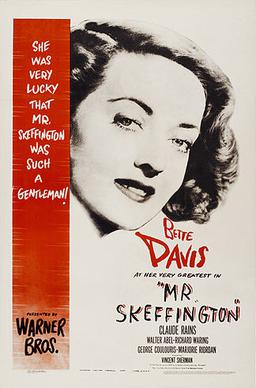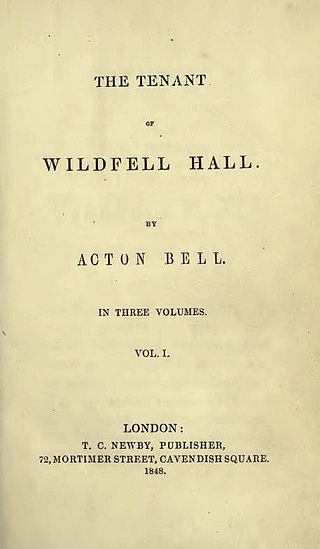Related Research Articles

Sense and Sensibility is the first novel by the English author Jane Austen, published in 1811. It was published anonymously; By A Lady appears on the title page where the author's name might have been. It tells the story of the Dashwood sisters, Elinor and Marianne as they come of age. They have an older half-brother, John, and a younger sister, Margaret.

Mr. Skeffington is a 1944 American drama film directed by Vincent Sherman, based on the 1940 novel of the same name by Elizabeth von Arnim.

The Tenant of Wildfell Hall is the second and final novel written by English author Anne Brontë. It was first published in 1848 under the pseudonym Acton Bell. Probably the most shocking of the Brontës' novels, it had an instant and phenomenal success, but after Anne's death her sister Charlotte prevented its re-publication in England until 1854.

The Mill on the Floss is a novel by English author George Eliot, first published in three volumes on 4 April 1860 by William Blackwood and Sons. The first American edition was published by Harper & Brothers, Publishers, New York.

Villette is an 1853 novel written by English author Charlotte Brontë. After an unspecified family disaster, the protagonist Lucy Snowe travels from her native England to the fictional Continental city of Villette to teach at a girls' school, where she is drawn into adventure and romance.

The History of Pendennis: His Fortunes and Misfortunes, His Friends and His Greatest Enemy (1848–50) is a novel by the English author William Makepeace Thackeray. It is set in 19th-century England, particularly in London. The main hero is a young English gentleman Arthur Pendennis, who is born in the country and sets out for London to seek his place in life and society. As such, it is generally categorized as a bildungsroman. The novel took two years for Thackeray to write and, in line with other Thackeray works, most notably Vanity Fair, it offers an insightful and satiric picture of human character and aristocratic society. The characters include the snobbish social hanger-on Major Pendennis and the tipsy Captain Costigan.

Arabella, Op. 79, is a lyric comedy, or opera, in three acts by Richard Strauss to a German libretto by Hugo von Hofmannsthal, their sixth and last operatic collaboration.
Oldtown Folks is an 1869 novel written by Harriet Beecher Stowe. It is written from the first-person perspective of a young man named Horace Holyoke, who describes his youth in fictional Oldtown, Massachusetts - including humorous depictions of daily life, behavior of local towns folk, and the adoption of Harry and Eglantine Percival.

Bath Tangle is a Regency romance novel by Georgette Heyer. The story is set in 1816.

Piccadilly Jim is a novel by P. G. Wodehouse, first published in the United States on 24 February 1917 by Dodd, Mead and Company, New York, and in the United Kingdom in May 1918 by Herbert Jenkins, London. The story had previously appeared in the US in the Saturday Evening Post between 16 September and 11 November 1916.
The Palliser novels are six novels written in series by Anthony Trollope. They were more commonly known as the Parliamentary novels prior to their 1974 television dramatisation by the BBC broadcast as The Pallisers. Marketed as "polite literature" during their initial publication, the novels encompass several literary genres including: family saga, bildungsroman, picaresque, as well as satire and parody of Victorian life, and criticism of the British government's predilection for attracting corrupt and corruptible people to power.

He Knew He Was Right is an 1869 novel written by Anthony Trollope which describes the failure of a marriage caused by the unreasonable jealousy of a husband exacerbated by the stubbornness of a willful wife. As is common with Trollope's works, there are also several substantial subplots. Trollope makes constant allusions to Shakespeare's Othello throughout the novel. Trollope considered this work to be a failure; he viewed the main character as unsympathetic, and the secondary characters and plots as much more lively and interesting, but it is one of his best known novels. It was adapted for BBC One in 2004 by Andrew Davies.

Stella Dallas is a 1937 American drama film based on the 1923 Olive Higgins Prouty novel of the same name. It was directed by King Vidor and stars Barbara Stanwyck, John Boles and Anne Shirley. The film was nominated for Academy Awards for Best Actress in a Leading Role and Best Actress in a Supporting Role.

The Way We Live Now is a 2001 four-part television adaptation of the Anthony Trollope 1875 novel The Way We Live Now. The serial was first broadcast on the BBC and was directed by David Yates, written by Andrew Davies and produced by Nigel Stafford-Clark. David Suchet starred as Augustus Melmotte, with Shirley Henderson as his daughter Marie, Matthew Macfadyen as Sir Felix Carbury, Cillian Murphy as Paul Montague and Miranda Otto as Mrs Hurtle.

Celestina is an eighteenth-century English novel and poet Charlotte Smith’s third novel. Published in 1791 by Thomas Cadell, the novel tells the story of an adopted orphan who discovers the secret of her parentage and marries the man she loves. It is a courtship novel that follows the typical Cinderella plot while still commenting on contemporary political issues.

The Fortunes and Misfortunes of Moll Flanders is a 1996 British drama television film directed by David Attwood, with a screenplay by Andrew Davies and starring Alex Kingston. It is an adaptation of the novel Moll Flanders by Daniel Defoe.

The Thirteenth Chair is a 1937 American mystery film directed by George B. Seitz and starring Dame May Whitty, Lewis Stone, Madge Evans, and Elissa Landi. It is based on the 1916 stage play of the same title by Bayard Veiller. This was the third film adaptation of the play. There was an earlier version by director Tod Browning in 1929, with Bela Lugosi in a supporting role, and an even earlier 1919 silent film adaptation that starred Creighton Hale.
References
- ↑ Lorna Sage (30 September 1999). The Cambridge Guide to Women's Writing in English . Cambridge University Press. pp. 547–. ISBN 978-0-521-66813-2.
- ↑ Gregg Crane (25 October 2007). The Cambridge Introduction to The Nineteenth-Century American Novel. Cambridge University Press. pp. 17–. ISBN 978-1-139-46565-6.